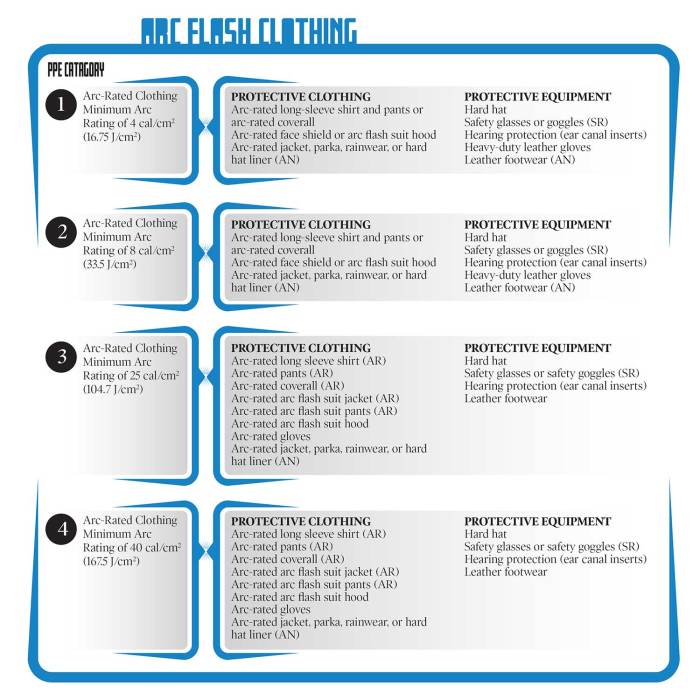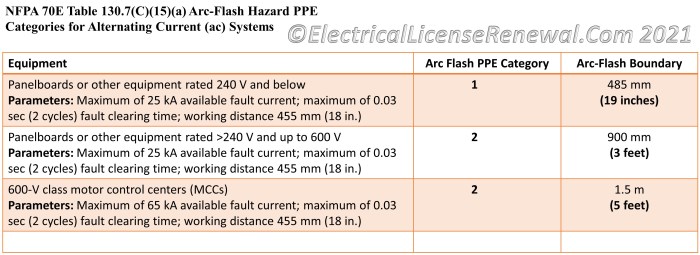Nfpa 70e table 130.7 c 15 a – NFPA 70E Table 130.7(C)(15)(a) stands as a cornerstone in the electrical safety realm, providing a comprehensive framework for assessing and mitigating arc flash hazards. This table serves as an indispensable tool for electrical professionals, empowering them to safeguard workers and prevent catastrophic events.
Within its meticulously crafted rows and columns, NFPA 70E Table 130.7(C)(15)(a) encapsulates a wealth of knowledge and guidance. It empowers electrical professionals to navigate the complexities of arc flash hazards, ensuring the safety of workers and the integrity of electrical systems.
NFPA 70E Table 130.7(C)(15)(a) Overview

NFPA 70E Table 130.7(C)(15)(a) is a comprehensive resource that provides guidance on the selection of personal protective equipment (PPE) for electrical workers. The table is based on the risk of electrical shock and arc flash, and it takes into account factors such as the voltage, the available fault current, and the working distance.
The table is divided into two main sections. The first section covers PPE for workers who are exposed to electrical shock hazards, and the second section covers PPE for workers who are exposed to arc flash hazards. Each section provides guidance on the type of PPE that is required, including the minimum arc rating, the flame resistance, and the electrical insulation.
PPE for Electrical Shock Hazards
The PPE requirements for workers who are exposed to electrical shock hazards are based on the voltage of the electrical system. The table provides guidance on the minimum arc rating, the flame resistance, and the electrical insulation required for each voltage level.
For example, workers who are exposed to voltages up to 50 volts are required to wear PPE with a minimum arc rating of 4 cal/cm2, a flame resistance of at least 2 seconds, and electrical insulation rated for the voltage level.
PPE for Arc Flash Hazards
The PPE requirements for workers who are exposed to arc flash hazards are based on the available fault current and the working distance. The table provides guidance on the minimum arc rating, the flame resistance, and the electrical insulation required for each combination of fault current and working distance.
For example, workers who are exposed to an available fault current of 10,000 amps and a working distance of 18 inches are required to wear PPE with a minimum arc rating of 40 cal/cm2, a flame resistance of at least 5 seconds, and electrical insulation rated for the voltage level.
Arc Flash Hazard Calculation Methods

Arc flash hazard calculation methods assess the potential severity of an arc flash incident. These methods consider factors such as system voltage, available fault current, and working distance to determine the incident energy and required personal protective equipment (PPE).The two primary arc flash hazard calculation methods are the IEEE 1584 method and the simplified method.
IEEE 1584 Method
The IEEE 1584 method is a comprehensive approach that provides detailed calculations for arc flash hazard assessment. It is based on the Institute of Electrical and Electronics Engineers (IEEE) Standard 1584, “Guide for Performing Arc-Flash Hazard Calculations.” The IEEE 1584 method considers various factors, including:
- System voltage
- Available fault current
- Working distance
- Arc duration
- Arc gap
- Enclosure type
The IEEE 1584 method provides accurate and detailed results, but it can be complex and time-consuming to apply.
Simplified Method
The simplified method is a less complex approach to arc flash hazard assessment. It is based on the National Fire Protection Association (NFPA) 70E, “Standard for Electrical Safety in the Workplace.” The simplified method uses a table to estimate the incident energy based on system voltage and available fault current.The
simplified method is easier to apply than the IEEE 1584 method, but it provides less detailed results.
Advantages and Disadvantages
The following table summarizes the advantages and disadvantages of the IEEE 1584 method and the simplified method:| Method | Advantages | Disadvantages ||—|—|—|| IEEE 1584 | Accurate and detailed results | Complex and time-consuming || Simplified | Easy to apply | Less detailed results |The choice of which method to use depends on the specific application and the level of accuracy required.
Factors Affecting Arc Flash Hazard

The severity of an arc flash hazard is influenced by a combination of factors related to the electrical system and the work environment. Understanding these factors is crucial for assessing and mitigating arc flash risks.
System Voltage
The voltage of the electrical system is a primary factor determining the severity of an arc flash. Higher voltages result in more significant arc flash hazards due to the increased energy stored in the system. As voltage increases, the potential for ionization of air and the formation of an arc plasma is greater, leading to a more intense and dangerous arc flash.
Fault Current, Nfpa 70e table 130.7 c 15 a
Fault current, also known as short-circuit current, is the amount of current that flows through an electrical system when a fault occurs. High fault currents can generate more intense arc flashes with greater energy release. The magnitude of the fault current depends on factors such as the system impedance, the source of the fault, and the characteristics of the protective devices.
Working Distance
The distance between a worker and the potential arc flash source is a critical factor in determining the severity of the hazard. The closer the worker is to the arc flash source, the greater the exposure to thermal radiation and other hazards.
Working at a safe distance from electrical equipment can significantly reduce the risk of injury or fatality in the event of an arc flash.
NFPA 70E Table 130.7(C)(15)(a) provides important guidance on electrical safety. However, for those with G6PD deficiency, it’s crucial to consider the safety of fluoride. Is fluoride safe for G6PD ? Understanding the potential risks and benefits is essential. When addressing electrical hazards as outlined in NFPA 70E Table 130.7(C)(15)(a),
it’s equally important to prioritize overall health and well-being.
PPE Requirements: Nfpa 70e Table 130.7 C 15 A
Personal Protective Equipment (PPE) plays a crucial role in safeguarding individuals from arc flash hazards. NFPA 70E Table 130.7(C)(15)(a) establishes specific PPE requirements based on the calculated arc flash hazard level.
Proper selection and use of PPE is paramount to ensure effective protection. It involves choosing the right PPE components, such as flame-resistant clothing, arc-rated face shields, and gloves, that meet or exceed the required arc flash hazard level.
PPE Components
- Flame-Resistant Clothing:Garments made of inherently flame-resistant materials or treated with flame-retardant chemicals to prevent ignition and minimize burn injuries.
- Arc-Rated Face Shields:Shields that protect the face and eyes from intense heat and flying debris, with an arc rating that matches or exceeds the calculated hazard level.
- Arc-Rated Gloves:Gloves made of materials with high electrical insulation properties to protect hands from electrical shock and burns.
- Other PPE:Additional PPE components may be required, such as hard hats, safety glasses, and hearing protection, depending on the specific work environment and tasks.
Safe Work Practices
To minimize arc flash hazards, NFPA 70E Table 130.7(C)(15)(a) recommends a set of safe work practices that are crucial for ensuring worker safety during electrical maintenance and operations.
Adhering to these practices is essential to reduce the risk of arc flash incidents and protect workers from potential injuries, such as burns, eye damage, or even fatalities.
Work Planning and Preparation
- Identify and assess potential arc flash hazards before starting any work.
- Establish clear work procedures and ensure all workers are familiar with them.
- Plan for contingencies, including emergency evacuation and rescue procedures.
Equipment and PPE
- Use properly rated and maintained electrical equipment, including tools and protective gear.
- Wear appropriate personal protective equipment (PPE), such as arc-rated clothing, face shields, and gloves.
- Inspect and test PPE regularly to ensure its integrity.
Work Execution
- Maintain a safe working distance from energized electrical equipment.
- Use proper grounding and bonding techniques to minimize the risk of electric shock.
- Avoid working alone and ensure there is a spotter present for added safety.
Post-Work Inspection and Maintenance
- Inspect equipment and PPE after use to identify any damage or defects.
- Perform regular maintenance and testing to ensure electrical equipment remains in safe operating condition.
- Document all inspections and maintenance activities for future reference.
Additional Considerations

Using NFPA 70E Table 130.7(C)(15)(a) requires careful consideration of additional factors that can influence the accuracy and effectiveness of the results.
Consulting with qualified electrical professionals is crucial for a comprehensive assessment and mitigation of arc flash hazards. Their expertise ensures a thorough understanding of the specific electrical system, potential hazards, and appropriate safety measures.
Limitations of the Table
- The table provides estimates of arc flash hazards based on specific assumptions and conditions.
- It may not be applicable to all electrical systems or configurations.
- The table does not consider the effects of specific equipment or protective devices that may alter the arc flash hazard.
Importance of Consulting Qualified Electrical Professionals
- They can evaluate the specific electrical system and identify potential arc flash hazards.
- They can perform detailed arc flash hazard analyses using more sophisticated methods, such as computer modeling or specialized software.
- They can recommend appropriate safety measures, including personal protective equipment (PPE), work practices, and engineering controls.
User Queries
What is the purpose of NFPA 70E Table 130.7(C)(15)(a)?
NFPA 70E Table 130.7(C)(15)(a) provides a comprehensive framework for assessing arc flash hazards and determining appropriate personal protective equipment (PPE) requirements.
How does NFPA 70E Table 130.7(C)(15)(a) help mitigate arc flash hazards?
By providing guidance on PPE selection and safe work practices, NFPA 70E Table 130.7(C)(15)(a) helps reduce the risk of injury or fatality from arc flash incidents.
What factors influence the severity of an arc flash hazard?
System voltage, fault current, and working distance are key factors that determine the severity of an arc flash hazard.